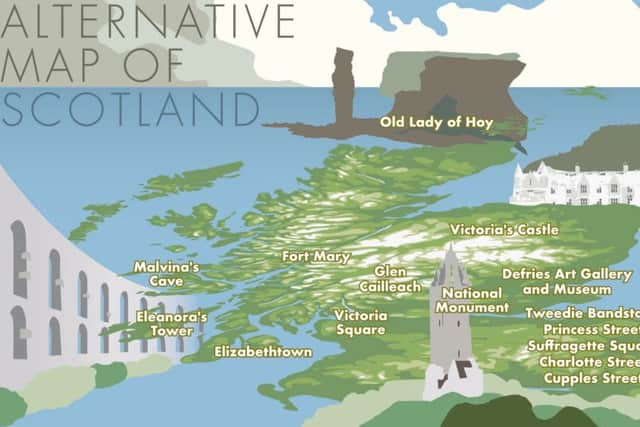Alternative map of Scotland renames famous landmarks after notable women
Historical novelist Sara Sheridan has created a guidebook featuring hundreds of true stories, which she says will “reveal a new picture of Scotland’s history and heritage.”
She hopes it will tackle the “male-dominated histories that have been repeated for generations.” It highlights where women are already honoured across Scotland, but also “reimagines” a different Scotland which recognises its “outstanding female heritage”, either by renaming existing places or suggesting suitable new tributes.
Advertisement
Hide AdPublicity material for the book, Where Are The Women?, to be published next month by the Scottish Government’s heritage agency, says it will be “dedicated to real women, telling their often untold or unknown stories.”


Historic Environment Scotland said it would celebrate women who had been “sidelined, if not silenced, by men who named the built environment after themselves.”
Edinburgh-born Sheridan suggests the city creates new honours for the likes of Dame Elsie Inglis, who set up the Scottish Women’s Hospitals in the First World War, at Edinburgh Castle, the author Dame Muriel Spark in Princes Street Gardens. She suggests St Andrew Square is instead known as Suffragette Square in honour of Bessie Watson, the child who piped for a huge demonstration on Princes Street in 1909.
Charlotte Street, George Street’s new incarnation, features memorials to Sophia Jex-Blake, who launched the fight to allow women to study at university, and the anti-slavery campaigner Eliza Wigham. St Giles’ Cathedral is renamed after the 14th century saint Catherine to honour Jenny Geddes, who famously threw a stool at the head of a minister in 1637.
In Glasgow, Sheridan envisages George Square as Victoria Square, with a striking new memorial of the monarch crowned with a traffic cone. Glasgow Green has a walkway honouring forgotten 1940s music hall star Doris Droy, while Nelson’s Column is renamed after Michelle Herbison, the Lanarkshire MP who became Harold Wilson’s Social Security Minister in the 1960s. A museum devoted to Scotland’s greatest sporting women is in the Gallowgate.
Sheridan renames Fingal’s Cave, on the island of Staffa, as Malvina’s Cave, after the lover of Oscar featured in the 18th century Ossian cycle of poems, while Campbeltown is named Elizabethtown after the Duchess of Argyll, who instigated its development as a seaport.
Advertisement
Hide AdOther places renamed include St Andrews as Magdalene, the Old Man of Hoy as the Old Lady of Hoy, Fort William as Fort Mary and the Wallace Monument as the National Monument.
Sheridan, named an “outstanding woman of Scotland by the Saltire Society in 2015, suggests the a permanent reminder of Scotland’s links to slavery in the 18th and 19th centuries is created in the Highlands.
Advertisement
Hide AdIn the book’s introduction, Sheridan says: “Each fictional street, building, statue and monument is dedicated to a real woman and tells their (often uncelebrated) stories. If we cannot imagine it, how can we build it? It’s been a huge task and also an honour.
“I’ve tried to create something worthy of our astounding female heritage. I hope the time is right and that we’re ready to look unflinchingly at the stories we tell and search for the pieces of our history that have been lost.
“Conversations about women in history and society have never been more relevant, and this guidebook seeks to contribute to those discussions by exploring the connections between and place – looking beyond the traditional male-dominated histories that have been repeated for generations.
“I look forward to the day when feminism is no longer relevant and we can simply use the word ‘equality,’ but I fear we’re nowhere near it.
“Ultimately, this book seeks to paint a companion picture of Scotland’s history. It is a challenge laid down to all people – men and women together.”